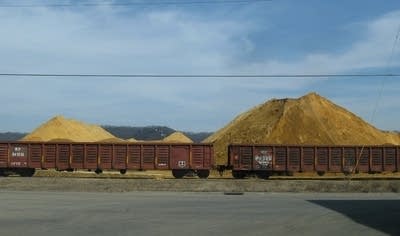Frac sand mining raises environmental, health concerns in SE Minnesota
Go Deeper.
Create an account or log in to save stories.
Like this?
Thanks for liking this story! We have added it to a list of your favorite stories.

Several local governments have imposed temporary bans on mining permits, but the moratoriums are coming to an end.
Southeastern Minnesota is ground zero for a fast-growing mining industry, due to the local geology. The Mississippi River flows between bluffs layered with stone and sand. Silica sand, or frac sand, is incredibly hard and perfect for the process of extracting oil and natural gas in a process called hydraulic fracturing, or fracking.
A frac sand mine is like a big gravel pit. Some cover 40 acres; others are 100 acres or more.
The mining process is straightforward. First, the topsoil is dug and typically piled in a berm around the perimeter of the mine. That can help reduce noise and dust for neighbors.
Turn Up Your Support
MPR News helps you turn down the noise and build shared understanding. Turn up your support for this public resource and keep trusted journalism accessible to all.
Then the sand is dug. Sometimes the hillside is blasted to loosen the sand. It is crushed, sorted, washed, dried, and then loaded into trucks for shipping by rail to oil and gas fields in places like North Dakota and Pennsylvania.
The main environmental and health concerns are about air and water quality.
Silica has long been known as a very harmful substance for people who work with it. At high concentrations it can scar the lungs, causing silicosis, an incurable disease. It can also cause cancer. The federal government has exposure limits for workers. But not for the general population, which could cover people living near the mines.
"The goal is to try to get some consistency in how the monitoring is carried out: the frequency, what is being monitored for, what type of monitors are utilized, how the data is reported,"
"You've got infants, children, elderly, that tend to be more susceptible. So occupational numbers don't take that into account and we do," said Dr. Hillary Carpenter, a toxicologist with the Minnesota Department of Health. He said a few states, including California and Texas, have set safe exposure levels for the general public.
He says Minnesota could use one of those standards. Air monitors are also needed to measure how much silica dust is blowing off the piles at the mines and processing plants.
"The problem here is there's no regulatory framework to require the companies to do it, and monitoring is not a cheap thing to do, so you've got to get a willing partner," Carpenter said.
Two operations have agreed to install monitors. Great Plains Sand in Jordan has six-months worth of data. They show levels that would meet California's standards. The other is a new operation that has not started work yet.
Mining companies are working with the Minnesota Pollution Control Agency to ensure future data can be usefully compared, said Kirsten Pauly, a consultant for the Minnesota Industrial Sand Council.
"I think the goal is to try to get some consistency in how the monitoring is carried out: the frequency, what is being monitored for, what type of monitors are utilized, how the data is reported," Pauly said, "so the data that's obtained can be compared apples to apples."
There are lots of things mines and processing plants can do to reduce the dust, including keeping it wet, Pauly said.
Meanwhile, people are exposed to silica dust from lots of other sources, including roads.
Any mine can raise concern about possible groundwater and aquifer contamination, because digging away the topsoil removes a natural filter. In parts of southeastern Minnesota, the frac sand comes in layers alternating with limestone.

That limestone can create sinkholes and cavities, said Ginny Yingling, of the Minnesota Department of Health.
"The result of that is that surface contamination can pass through those cavities very rapidly and impact peoples' wells in a very large area, because the water can travel so fast and so far without any real filtering," Yingling said.
Contaminants could include chemicals used to help clean the sand. Yingling said the government has not set drinking water standards for some of them, and there are not many labs that can test for them.
"It may or may not be a problem; we just don't know yet," Yingling said "That's our real issue, is that we don't have enough information from other sites like these, of how much of a problem we're going to have."
Other concerns for some local residents include increased truck traffic, with associated diesel emissions, wear and tear on roads, and potential for accidents.
Wisconsin has numerous active frac sand mines — 36 facilities as of January 2013, according to the Wisconsin Department of Natural Resources. Minnesota regulators only know of eight. Neither state can say with confidence whether the mines present public health concerns.
Frac sand mining is a hot button topic. Several local groups have asked the state for a ban on new mines while more research is done.
Another option is a study called a Health Impact Analysis, similar to a full-scale Environmental Impact Statement but quicker to conduct.
Lawmakers will take up the matter at a joint meeting of the Senate and House energy policy committees Tuesday.




